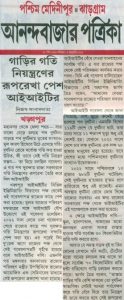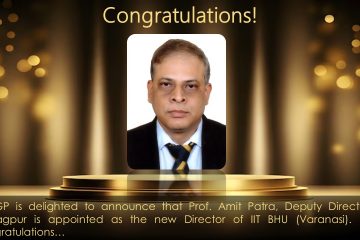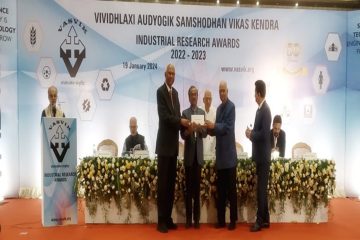The civil engineering department of the Indian Institute of Technology (IIT), Kharagpur, along with Paribahan Bhawan, transport department headquarters on R N Mukherjee Road, launched a study document on policy interventions and roadmap for effective implementations of speed management in the city and districts in a programme scheduled on 9th January 2024.
Transport Minister Snehashis Chakraborty; State Transport Secretary Saumitra Mohan; Director-Transport; Secretary -School Education; Deputy Commissioner of Police (Traffic)-Kolkata Traffic Police; Inspector General of Police- West Bengal Police; Regional Officer-National Highways Authority of India; Joint Secretary-Urban Development; other dignitaries and Prof. Bhargab Maitra of IIT Kharagpur launched the document. After a thorough study of more than two years since 2022, the IIT Kharagpur has prepared the roadmap making recommendations on maximum speed limits of vehicles plying on different National Highways (NHs), state highways (SHs), and other roads under local administrations in the state.

For the first time, the state transport department is all set to limit maximum speed of vehicles plying across the state to prevent an increase in the number of deaths caused by road accidents.
“The state transport department has accepted our document and roadmap on how to prevent road accidents and deaths in our state. The purpose of this move is to communicate the idea of prevention and control speed so that the number of accidents comes down. Common people will get benefits once recommendations made by us are implemented by the state government,” added Prof. Bhargab Moitra, Department of Civil Engineering, IIT Kharagpur and transport specialist who was the lead expert of the study.
The document revealed that speeding vehicles are the single largest cause of road accidents in the state, which records 6,000 deaths every year on an average. The state also ranks 11 in terms of deaths caused by fatal road accidents in the country that comes in the top in the world considering the highest number of 450 deaths daily.
It also threw light on how speed and accident fatality are scientifically inter-related. For instance, maximum speed for a motor vehicle should not cross 30 kmph in roads close to markets, schools, hospitals etc., and have capped the speed limits for all vehicles at 50km/hr on major arterial roads, where pedestrians, two-wheeler-riders and non-mechanized transport are largely protected or segregated from motorized and speedier modes of traffic.

On a separate segment of urban roads, which does not require a speed limit of 30 km/hr but does not qualify for 50 km/hr speed limits either. Vehicles can be allowed 40 km/hr, the document states that for long, elevated corridors or at-grade segments, where there is no pedestrian or bicyclist, no roadside friction no buses and trucks, and where two-wheelers are separated a higher speed limit may be accepted for cars and similar light vehicles. But the speed for two-wheelers should be restricted to not beyond 50 km/hr said the document, which is largely applicable for urban roads.
“The safe speed limit is also a function of traffic volume and therefore, might be lower under high volume to capacity ratio, the experts have argued stating why two separate maximum speed regimes can be followed. Under some extreme conditions, the safe speed limit might be even lower than that recommended in front of schools, “Therefore, drivers must apply their discretion and bring down the speed under such conditions,” said Prof. Maitra.
The report also talks of faulty use of traffic tools in front of schools and why it is necessary to use scientific and why it is necessary to use scientific and modern road designs in front of school gates. “Several speed management and traffic calming measures across all types of roads such as speed breakers and rumble strips which are already existing are inappropriate in many ways and are not effective and in many cases are acting as safety hazards. To determine their appropriateness in terms of suitability, design, and placement, extensive audit of the existing speed management and traffic-calming measures is very necessary. This is all the more true for roads in front of schools,” said an expert.
“Besides speed limits, modifications in infrastructure plan and design features should be used to produce a ‘self-explaining road’. Road development authority should be continuously involved in improving the road engineering aspects to make the roads safer in the schools,” the note states. The document reportedly also stressed on the use of speed governors on all vehicles carrying school students.
Speed limits in roads where pedestrians are not protected properly should also be restricted strongly by law enforcing authorities. There should be highend electronic-based evidence systems to monitor speed limits so that police can take proper action against speeding vehicles, the document recommends. Police personnel should be more responsible to take strong actions against speeding vehicles after verifying electronic-based evidence.
In 2022, the share of road crash fatalities due to speeding in the state is found to be 32.3%. Around 70% of the fatalities include pedestrians, cyclists and motorcycle riders, who share the same road space as high-speed vehicles effective speed management becomes a matter of necessity as a means of reducing road crashes and fatalities, were shared in the document.
Media Coverage:
| Times of India | Telegraph | Statesman |
| Millennium Post | News 18 | ETV Bharat |
| Ananda Bazar Patrika |

Follow up articles:
- Times of India – https://timesofindia.indiatimes.com/city/kolkata/iit-study-recommends-lower-vehicle-speed-in-school-zones-during-opening-hours/articleshow/106745023.cms
- Statesman – https://www.thestatesman.com/bengal/safe-corridors-to-minimise-road-accidents-1503258034.html
Study By : Prof. Bhargab Maitra, Dept. of Civil Engineering, IIT Kharagpur
Email: bhargab@civil.iitkgp.ac.in
By : Poulami Mondal, Digital & Creative Media Executive (Creative Writer)
Email: poulami.mondal@iitkgp.ac.in, media@iitkgp.ac.in, Ph. No.: +91-3222-282007
Follow us on: Facebook – IIT Kharagpur; Twitter – @IITKgp; Instagram – @iit.kgp; LinkedIn – Indian Institute of Technology
For news visit: https://kgpchronicle.iitkgp.ac.in/



